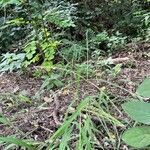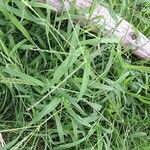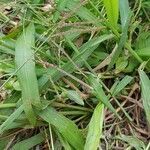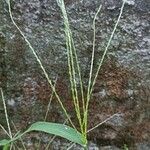Annual. Culms decumbent at base, branching and rooting at lower nodes, 30–100 cm tall. Leaf sheaths ± pilose; leaf blades linear to linear-lanceolate, 5–20 × 0.3–1 cm, adaxial surface usually pilose, margins thickened and scabrous; ligule 1–2 mm. Inflorescence digitate or subdigitate, axis short; racemes 3–10, 5–17 cm; spikelets paired, imbricate by about 2/3 their length; rachis winged, ca. 1 mm broad, midrib triquetrous, margins scabrous. Spikelets lanceolate, 2.5–3.5 mm, acute; lower glume very small, triangular; upper glume lanceolate, 2/3–4/5 as long as spikelet, 3-veined, pilose; lower lemma as long as spikelet, 7-veined, veins evenly spaced or a broader glabrous interspace flanking the midvein, lateral interveins appressed pubescent to ciliate or villous, sometimes with a halo-like fringe, sometimes setose; upper lemma yellowish green, gray or pale brown, elliptic, as long as lower lemma, apex acuminate. Fl. and fr. May–Oct. 2n = 36, 54, 72.
Loosely tufted or solitary growing annual, 200-550 mm high; decumbent to erect. Leaf blade 30-130 x 3-10 mm; ligule an unfringed membrane. Inflorescence digitate to subdigitate, of 3-7 racemes; rachis triquetrous, broadly winged, glabrous with scabrous margins; pedicels triangular, scabrous; spikelets abaxial, paired. Spikelets 2.3-3.4 x 1 mm, dorsiventrally compressed; lower glume a triangular scale 0.25-0.50 mm long; upper glume shorter than spikelet, 3-nerved, pubescent; internode absent. Florets 2; lower floret sterile, lemma lanceolate, usually as long as spikelet, pubescent, 7-nerved, nerves smooth; upper floret bisexual, lemma ± as long as spikelet, yellow to brown, margins flat and covering most of palea. Flowering time Jan.-Apr.
Loosely tufted or solitary growing annual 200-550 mm high; culms decumbent to erect. Leaf blade 30-160 x 3-10 mm; margins scabrid. Inflorescence digitate to subdigitate, of 2-9 racemes, 40-120 mm long; rachis triquetrous, broadly winged, glabrous, margins scabrous; pedicel triangular, scabrous; spikelets paired. Spikelet 2.3-3.4 x 1 mm; lower glume a triangular scale 0.25-0.50 mm long; upper glume shorter than spikelet, 3-nerved, adpressed hairy, hairs fine, acute; internode absent; lower lemma as long as spikelet, acute, hairy, 7-nerved, nerves usually smooth, bristle hairs sometimes present; upper lemma as long as to shorter than spikelet, yellow to pale brown; anthers 0.8-1.4 mm long.
Much like no. 4 [Digitaria sanguinalis (L.) Scop.], and intergrading with it; blades glabrous or only sparsely papillose-pilose on the upper surface near the throat; spikelets 2.7–3.6 mm; second glume (1–)1.5–2.5 mm, half to four-fifths the length of the spikelet; lateral veins of the sterile lemma smooth; 2n mostly = 54. A weed as no. 4, but more southern; trop. Amer., n. to Va., s. Ind., Mo., and s. Nebr. (D. adscendens)
A wild millet grass. It is an annual grass. It branches and roots at the lower nodes. It is 30-100 cm tall. The leaf blade is 5-20 cm long. The flowering stalk has 3 spike like stalks each 3-20 cm long. The spikelets are 2.5-3.5 mm long. It is a very variable plant.
Annual; up to 0.55 m high; tufted. Culms erect. Leaf blades 30-160 x 3-10 mm. Flowers: inflorescence digitate; racemes 3-7; digitate; 40-100 mm long; spikelets 2.3-3.4 x 1 mm; lower glume a triangular scale up to 0.3 mm long; lower lemma not scaberulous.
Annual, tufted, up to 0.55 m high. Leaf blades 30-160 mm long, 3-10 mm wide. Spikelets 2.3-3.4 mm long, 1 mm wide. Racemes 3-7, digitate, 40-100 mm long; lower glume a triangular scale up to 0.3 mm long; lower lemma not scaberulous.




